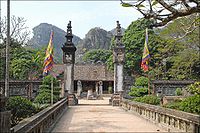- Đinh dynasty
-
History of Vietnam 
Hồng Bàng dynasty prior to 257 BC Thục dynasty 257–207 BC Triệu dynasty 207–111 BC First Chinese domination 111 BC–39 AD Trưng sisters 40–43 Second Chinese domination 43–544 Early Lý dynasty 544–602 Third Chinese domination 602–905 Autonomy 905–938 Ngô dynasty 939–967 Đinh dynasty 968–980 Early Lê dynasty 980–1009 Lý dynasty 1009–1225 Trần dynasty 1225–1400 Hồ dynasty 1400–1407 Fourth Chinese domination 1407–1427 • Later Trần dynasty 1407–1413 Later Lê dynasty (Early Lê) 1428–1527 Mạc dynasty 1527–1592 Later Lê dynasty (Restored Lê) 1533–1788 • Trịnh Lords 1545–1787 • Nguyễn Lords 1558–1777 Tây Sơn dynasty 1778–1802 Nguyễn dynasty 1802–1945 • French imperialism 1887–1954 Partition 1954–1975 • Democratic Republic (North) 1945–1976 • State of Vietnam (South) 1949–1955 • Republic of Vietnam (South) 1955–1975 Socialist Republic from 1976 Related topics Champa Dynasties 192–1832 List of Vietnamese monarchs
Economic history of Vietnam
Prehistoric cultures of VietnamThe Đinh dynasty (Vietnamese: Nhà Đinh; Han-Viet: 丁 朝, Đinh Triều) was the imperial dynasty of Vietnam starting in 968 when Đinh Tiên Hoàng vanquished the upheavals of Twelve warlords and ended as the son of Đinh Tiên Hoàng, Đinh Phế Đế, ceded the throne to Lê Hoàn, and ending in 980.
Contents
Đinh Bộ Lĩnh's childhood
Đinh Bộ Lĩnh's father was Đinh Công Trứ, a mandarin under the reigns of Ngô Quyền (939–944) and Ngô Xương Văn (950–954). Đinh Công Trứ died while Bộ Lĩnh was still very young. His mother then took him back to her village to live with her family. There Đinh Bộ Lĩnh attended the village school and in his free time rode atop water buffaloes and played games with other children. When he reached adulthood he joined Trần Minh Công (Trần Lãm), one of the Thập Nhị Sứ Quân or 12 Sứ Quân (12 lords fighting each other) who made him a general due to his skills and talents.
Rise to Emperor (965–980)
One by one, Đinh Bộ Lĩnh (924–979) defeated or subdued the other 11 lords. His multitude victories over other lords earned him the title Vạn Thắng Vương, which means "King of Ten Thousand Victories." After unifying the country in 968 and bringing peace back to the land, he proclaimed himself Đinh Tiên Hoàng Đế. He renamed the country "Đại Cồ Việt." Worried that his country was still weak (where outside influences could be easily made), he sought to strengthen the government by appointing military men to important positions. Among his top generals were Nguyễn Bạc, his oldest son Đinh Liễn, Lê Hoàn, etc. The latter became a major figure for the Đinh Dynasty succession and the rise of the Anterior Lê Dynasty.
Đinh Tiên Hoàng's succession (980)
The end of Đinh Tien Hoàng's reign was marked by the following successive events.
- He removed his oldest son Đinh Liễn from the throne as he had decided to have his second son, Đinh Hang Lăng, succeed him. His infant son, Đinh Tuệ, would be next in line.
- One night in 980, as Đinh Tiên Hoàng and his son Đinh Liễn were having a party, a mandarin official sneacked into the palace and killed both father and son. Thus fate decreed that the infant son Đinh Tuệ would inherit the kingdom.
Đinh Phế Đế (980) and the threat from the North
When Đinh Tuệ became emperor, because of his age, his mother the Dowager Empress Dương Vân Nga assumed the role of regent. While all of these events were taking place, to the north, China was enduring some dynastic changes. The Song Dynasty had reunified the country for the first time since the fall of the Tang. The Song Dynasty would last until the end of the 13th century; when they in turn were overrun by the Mongol Yuan Dynasty under Genghis Khan. The turmoil of succession of Đinh Tiên Hoàng in their southern border gave the Chinese Song a pretext to meddle and interfere into the matters of the Vietnamese, to invade the country and subjugate it again to their rule.
Lê Hoàn's ascension to the throne (980)
Appalled by this new threat, the Dowager Empress Dương Vân Nga threw her support to Lê Hoàn who was now commander-in-chief of the army. To confront the Song army who had already arrived at the border, the Empress Dowager agreed to recognize Lê Hoàn and let him step up to the throne as a new king. With the crowning of Lê Hoàn, the Anterior Lê Dynasty was founded. As Lê Hoàn was being crowned Emperor, the Song army approached the boundary of the two countries.
Preceded by
Ngô DynastyDynasty of Vietnam
968–980Succeeded by
Prior Lê DynastyNotable families in early independent Vietnam Colour note DươngKiềuLêKhúc Thừa Dụ Khúc Hạo Dương Đình Nghệ Khúc Thừa Mỹ Ngô Quyền Queen Dương Đinh Công Trứ Dương Tam Kha Kiều Công Tiễn Ngô Xương Ngập Ngô Xương Văn Đinh Tiên Hoàng Dương Vân Nga Lê Đại Hành Kiều Công Chuẩn Ngô Nhật Khánh Ngô Xương Xí Đinh Liễn Đinh Hạng Lang Đinh Phế Đế Kiều Công Hãn Princess Phất Kim Lê Long Việt Lê Long Đĩnh Kiều Thuận Family tree of Vietnamese monarchs Overall Early independence Lý Dynasty Trần Dynasty Lê Dynasty Trịnh Lords and Mạc Dynasty Nguyễn Lords and Dynasty Categories:
Wikimedia Foundation. 2010.

